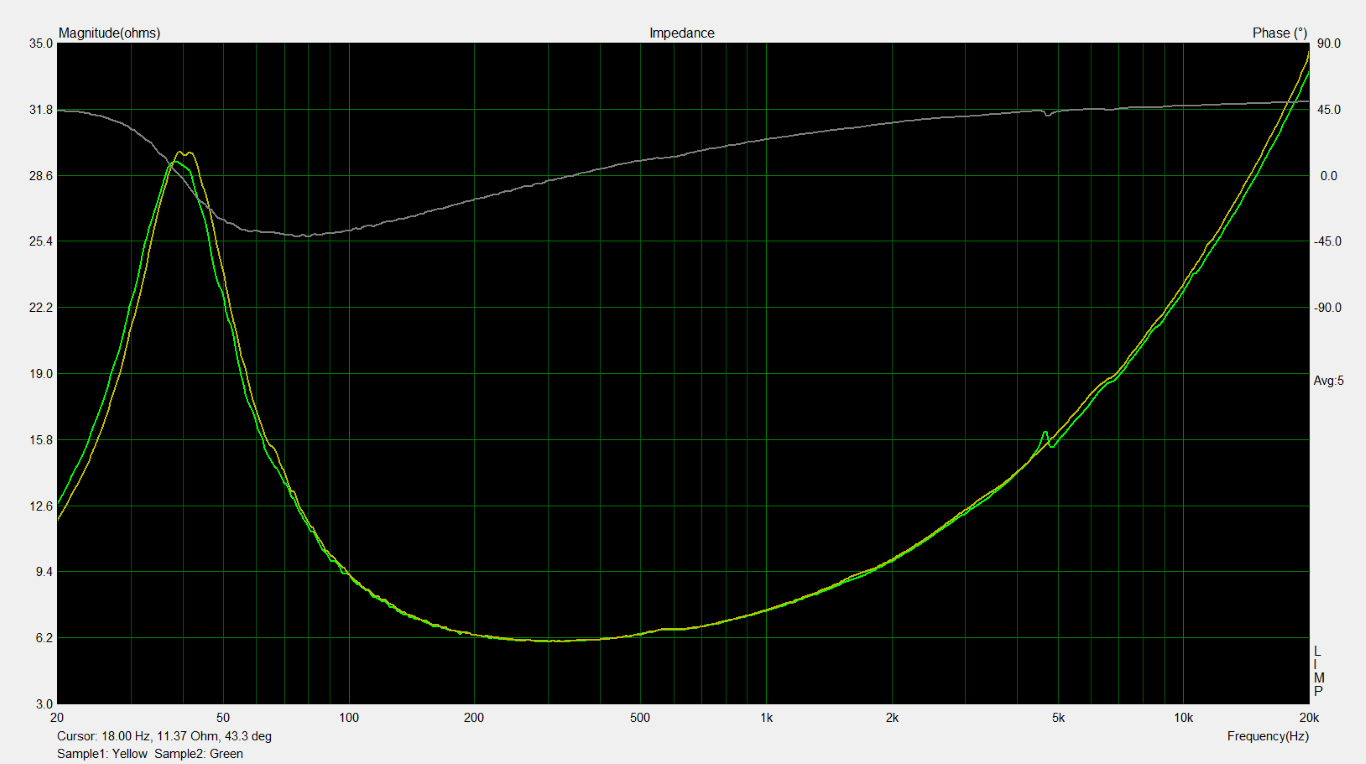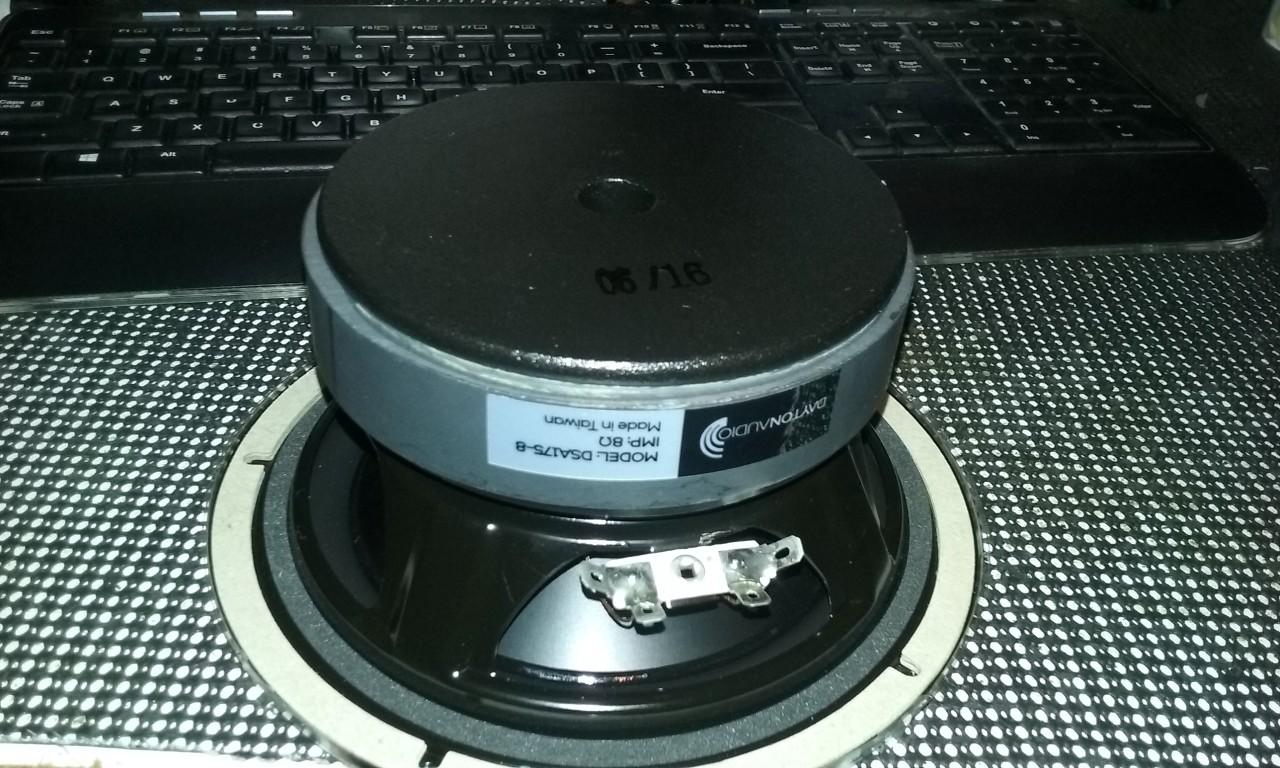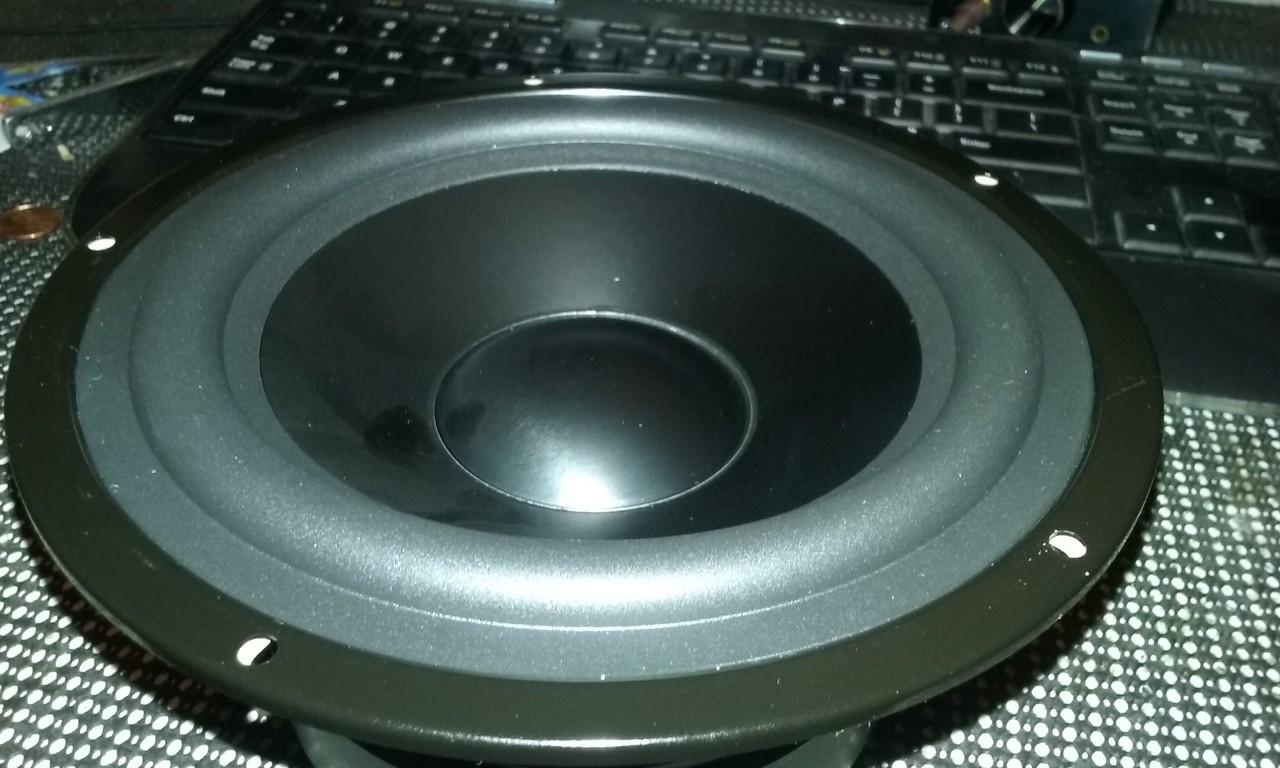Site Links
Howdy, Stranger!
It looks like you're new here. If you want to get involved, click one of these buttons!
Quick Links
Categories
Who's Online (0)
Dayton Audio DSA175-8
OK, these guys arrive yesterday and I had some time this morning before work to take a look. For starters, the cone is very attractive. The dustcap is aluminum - which I was pleasantly surprised at. I was expecting the same cheap looking treated fabric style that appears on the DA series. Minimal glue squeeze out between dustcap and cone, too.
The motor is large, but... the only voice coil venting is the vent out the backside. It is about 12mm in diameter, and while I would like to see a roundover on the vent (along with under dustcap or underspider venting) it is what it is.
One serious drawback to this driver is the frame. It is extremely flimsy - that cardboard gasket they provide under the mounting lip isn't meant to do us any favors as a sealing agent - it keeps screws from destroying the cheapass frame. It is ~0.8mm thickness. In constrast to that, a buyout 4" I have sitting on the desk (because I like how it looks with it's old fashioned dimpled poly cone and greenish looking surround) is 1.0mm. And sorry, Dayton - i know it will be buried in a cabinet, but the orange peeled finish on the frame along with an obvious touch-up job just further drives home how cheap these frames really are. I mean, these frames are cheaper than a buyout driver from Orevox that used to retail on their website for $14/pr./Rant
Since there is no way to peer at the motor internals without wrecking it, I cannot say for sure what type of shorting ring it is - is it copper? Is it aluminum? Is it even effective one iota? Impedance curves imply it has minimal effect.
Sample 1:
Sample 2:
Decent enough unit-to-unit, although I have seen better from Dayton in the past.
Of greater concern to me is the blip in the impedance on Sample2:

That implies a significant difference in break-up behavior unit-to-unit. I am very curious to see Craig and Ron's impedance sweeps - maybe one of mine is an outlier. They are marked, so when I take some in-box I will post the corresponding FR curves. This could be a deal breaker for me, we'll see.
I am liking these in my 0.38 cabinets, tuned to high 40's or so. Should be bassy enough for music.


So anyways, here ends this review for now. Based on build quality and unit-to-unit, so far I am rating these a solid "C".
The motor is large, but... the only voice coil venting is the vent out the backside. It is about 12mm in diameter, and while I would like to see a roundover on the vent (along with under dustcap or underspider venting) it is what it is.
One serious drawback to this driver is the frame. It is extremely flimsy - that cardboard gasket they provide under the mounting lip isn't meant to do us any favors as a sealing agent - it keeps screws from destroying the cheapass frame. It is ~0.8mm thickness. In constrast to that, a buyout 4" I have sitting on the desk (because I like how it looks with it's old fashioned dimpled poly cone and greenish looking surround) is 1.0mm. And sorry, Dayton - i know it will be buried in a cabinet, but the orange peeled finish on the frame along with an obvious touch-up job just further drives home how cheap these frames really are. I mean, these frames are cheaper than a buyout driver from Orevox that used to retail on their website for $14/pr./Rant
Since there is no way to peer at the motor internals without wrecking it, I cannot say for sure what type of shorting ring it is - is it copper? Is it aluminum? Is it even effective one iota? Impedance curves imply it has minimal effect.
Sample 1:
Thiele-Small parameters:
Fs = 39.47 Hz
Re = 5.45 ohms[dc]
Le = 193.29 uH
L2 = 497.67 uH
R2 = 12.29 ohms
Qt = 0.31
Qes = 0.38
Qms = 1.69
Mms = 21.07 grams
Rms = 3.082220 kg/s
Cms = 0.000772 m/N
Vas = 17.95 liters
Sd= 128.68 cm^2
Bl = 8.605253 Tm
ETA = 0.28 %
Lp(2.83V/1m) = 88.18 dB
Added Mass Method:
Added mass = 20.00 grams
Diameter= 12.80 cm
Sample 2:
Thiele-Small parameters:
Fs = 41.63 Hz
Re = 5.48 ohms[dc]
Le = 198.87 uH
L2 = 503.78 uH
R2 = 12.55 ohms
Qt = 0.29
Qes = 0.36
Qms = 1.59
Mms = 16.73 grams
Rms = 2.754248 kg/s
Cms = 0.000874 m/N
Vas = 20.32 liters
Sd= 128.68 cm^2
Bl = 8.173118 Tm
ETA = 0.39 %
Lp(2.83V/1m) = 89.69 dB
Added Mass Method:
Added mass = 20.00 grams
Diameter= 12.80 cm
Decent enough unit-to-unit, although I have seen better from Dayton in the past.
Of greater concern to me is the blip in the impedance on Sample2:

That implies a significant difference in break-up behavior unit-to-unit. I am very curious to see Craig and Ron's impedance sweeps - maybe one of mine is an outlier. They are marked, so when I take some in-box I will post the corresponding FR curves. This could be a deal breaker for me, we'll see.
I am liking these in my 0.38 cabinets, tuned to high 40's or so. Should be bassy enough for music.


So anyways, here ends this review for now. Based on build quality and unit-to-unit, so far I am rating these a solid "C".
I have a signature.



Comments
I am trying to decide if using such a flimsy basket is a good tradeoff for implementing a large motor. On the one hand, there are dozens upon dozens of drivers available for the same or less money that use very nice cast baskets. On the other hand, I understand Dayton Audio's decision to not engineer these too close to the Reference series.
From what I recall, there are reasons beyond stiffness that make an aluminum or even a plastic basket desirable over steel - something to do with the magnetic field and saturation. I could be mistaken, however, as it has been many years since I looked into it.